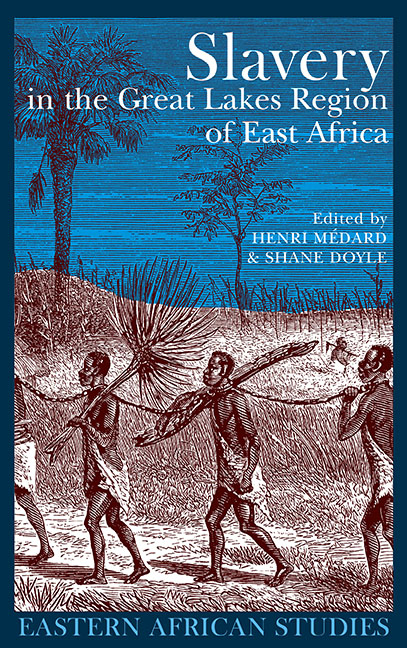Book contents
- Frontmatter
- Dedication
- Contents
- List of Maps & Tables
- Notes on Contributors
- Introduction
- 1 Violence, Marginality, Scorn & Honour: Language evidence of slavery to the eighteenth century
- 2 Notes on the Rise of Slavery & Social Change in Unyamwezi c. 1860 –1900
- 3 Slavery & Forced Labour in the Eastern Congo 1850 –1910
- 4 Legacies of Slavery in North West Uganda: The story of the ‘One-Elevens’
- 5 Human Booty in Buganda: Some observations on the seizure of people in war c.1700 –1890
- 6 Stolen People & Autonomous Chiefs in Nineteenth-Century Buganda: The social consequences of non-free followers
- 7 Women's Experiences of Enslavement & Slavery in Late Nineteenth- & Early Twentieth-Century Uganda
- 8 Slavery & Other Forms of Social Oppression in Ankole 1890 –1940
- 9 The Slave Trade in Burundi & Rwanda at the Beginning of German Colonisation 1890 –1906
- 10 Bunyoro & the Demography of Slavery Debate: Fertility, kinship & assimilation
- References
- Index
7 - Women's Experiences of Enslavement & Slavery in Late Nineteenth- & Early Twentieth-Century Uganda
Published online by Cambridge University Press: 11 August 2017
- Frontmatter
- Dedication
- Contents
- List of Maps & Tables
- Notes on Contributors
- Introduction
- 1 Violence, Marginality, Scorn & Honour: Language evidence of slavery to the eighteenth century
- 2 Notes on the Rise of Slavery & Social Change in Unyamwezi c. 1860 –1900
- 3 Slavery & Forced Labour in the Eastern Congo 1850 –1910
- 4 Legacies of Slavery in North West Uganda: The story of the ‘One-Elevens’
- 5 Human Booty in Buganda: Some observations on the seizure of people in war c.1700 –1890
- 6 Stolen People & Autonomous Chiefs in Nineteenth-Century Buganda: The social consequences of non-free followers
- 7 Women's Experiences of Enslavement & Slavery in Late Nineteenth- & Early Twentieth-Century Uganda
- 8 Slavery & Other Forms of Social Oppression in Ankole 1890 –1940
- 9 The Slave Trade in Burundi & Rwanda at the Beginning of German Colonisation 1890 –1906
- 10 Bunyoro & the Demography of Slavery Debate: Fertility, kinship & assimilation
- References
- Index
Summary
Introduction
The subject of slavery remains one of the key issues in African studies and, as the Introduction to this book makes clear, the subject of slavery and slave trading in East Africa has been relatively understudied. I would go even further to contend that the aspect of slavery about which we have the least detailed information is the lives of people in slavery. One problem has been a lack of sources. Recently I uncovered some material which, when added to known sources, will help to shed light on women's enslavement and their lives as slaves in Uganda, especially in the kingdom of Buganda. This chapter focuses on women because of their importance to the institution of slavery within Africa, and to societies in Uganda.
Since the strength of this essay is the sources, some explanation of them is required. The major sources used are descriptions of the lives of fifty-fi women who were slaves or held servile status in Uganda in the latter part of the nineteenth century. The women, or the men to whom they were connected, were preparing for Catholic baptism and the accounts are attempts by the Catholic missionaries to sort out their marriage histories. These accounts, known as ‘Marriage Cases’, were recorded by priests from the Saint Joseph's Foreign Missionary Society, known more colloquially as the Mill Hill Mission. While the individual accounts are not as long or detailed as some well-known sources from East Africa, the main value here is the number of examples. Most sources on slavery in Buganda consist of statements about categories of slaves and generalisations about what slave status was like. These records give us the best view we have of women's actual lives in slavery, and allow us to make general statements on a firmer foundation. Going beyond that, having fifty-fiv accounts means that we can see patterns in women's experiences that individual accounts cannot offer. Another point that makes these sources valuable is that they come from areas not only outside the capital, but even outside the centre of Buganda.
- Type
- Chapter
- Information
- Slavery in the Great Lakes Region of East Africa , pp. 174 - 188Publisher: Boydell & BrewerPrint publication year: 2007

